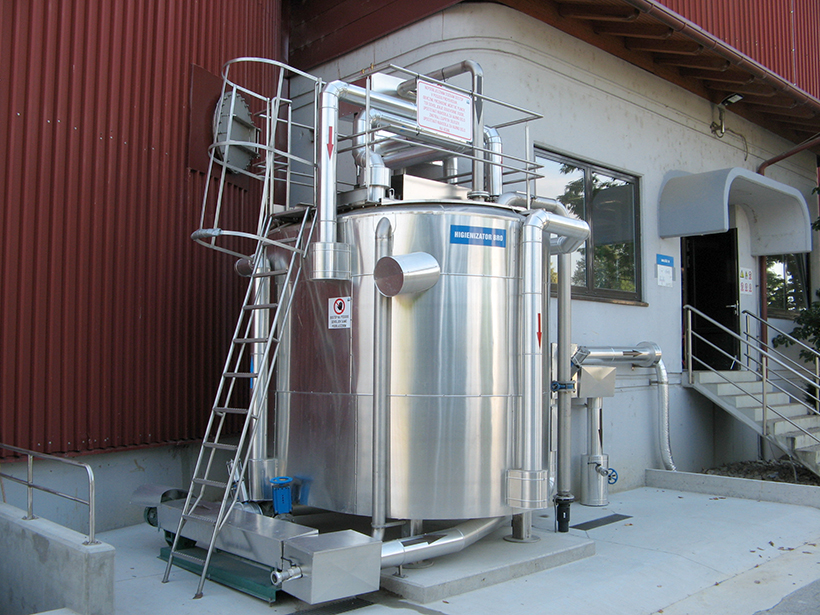Next to the primary clarifier, there is a facility for receiving liquid biodegradable waste.
Non-hazardous biodegradable waste is processed using anaerobic decomposition and converted into biogas (operation R3/R1). 30 tons may be treated daily. Liquid waste is pumped from the storage tank into the hygienisation tank where heaters heat the liquid waste at 70 degrees Celsius for 1 hour. After the hygienisation, the liquid waste is pumped into a separate anaerobic digester of total volume of 1,800 cubic metres.
There the aerobic conversion of organic matter into biogas takes place over a period of 30 days at a temperature of approximately 39 degrees Celsius. The first stage involves acid hydrolysis, during which organic matter decomposes into short-chain fatty acids. Then follows the methanogenic phase in which methanogenic bacteria convert the fatty acids into biogas.
The resulting biogas is stored in the gasholder while the digested sludge undergoes a mechanical thickening in a centrifuge until the content of dry matter reaches approximately 30 percent. Thickened sludge is stored at the disposal site ready for final disposal. The pumps then transfer the water or centrate, the product of centrifugation, to a storage tank where it undergoes deammonification.
BIOGAS is a mixture of approximately 65 percent of methane, 34 percent of carbon dioxide and 1 percent of other gases. After digestion, the biogas passes from the gasholder through a column containing activated carbon, which removes impurities, such as organic silicon compounds, solvents and sulphide., The biogas is used to fuel biogas engines to produce electricity. The electricity produced covers over 90 percent of the plant's energy needs, and provides all the heat energy required by the wastewater treatment processes. Any excess electricity generated goes back into the electrical grid, while flares dispose of any excess biogas.
Tabel 1:
Waste Classfication – List of Waste (operation R3/R1)
Non-hazardous biodegradable waste (hygienisation of liquid waste)
| Waste Classification | List of Waste |
| 02 01 01 | sludges from washing and cleaning |
| 02 01 03 | plant-tissue waste |
| 02 02 03 | materials unsuitable for consumption or processing |
| 02 02 04 | sludges from on-site effluent treatment |
| 02 03 01 | sludges from washing, cleaning, peeling, centrifuging and separation |
| 02 03 04 | materials unsuitable for consumption or processing |
| 02 03 05 | sludges from on-site effluent treatment |
| 02 04 03 | sludges from on-site effluent treatment |
| 02 05 01 | materials unsuitable for consumption or processing |
| 02 05 02 | sludges from on-site effluent treatment |
| 02 06 01 | materials unsuitable for consumption or processing |
| 02 06 03 | sludges from on-site effluent treatment |
| 02 07 01 | wastes from washing, cleaning and mechanical reduction of raw materials |
| 02 07 02 | wastes from spirits distillation |
| 02 07 04 | materials unsuitable for consumption or processing |
| 02 07 05 | sludges from on-site effluent treatment |
| 03 03 10 | fibre rejects, fibre-, filler- and coating-sludges from mechanical separation |
| 03 03 11 | sludges from on-site effluent treatment other than those mentioned in 03 03 10 |
| 04 02 20 | sludges from on-site effluent treatment other than those mentioned in 04 02 19 |
| 07 05 14 | solid wastes other than those mentioned in 07 05 13 |
| 08 04 10 | waste adhesives and sealants other than those mentioned in 08 04 09 |
| 08 04 12 | adhesive and sealant sludges other than those mentioned in 08 04 11 |
| 08 04 14 | aqueous sludges containing adhesives or sealants other than those mentioned in 08 04 13 |
| 16 03 06 | organic wastes other than those mentioned in 16 03 05 |
| 19 05 03 | off-specification compost |
| 19 06 05 | liquor from anaerobic treatment of animal and vegetable waste |
| 19 06 06 | digestate from anaerobic treatment of animal and vegetable waste |
| 19 08 05 | sludges from treatment of urban waste water |
| 19 08 09 | grease and oil mixture from oil/water separation containing only edible oil and fats |
| 19 08 12 | sludges from biological treatment of industrial waste water other than those mentioned in 19 08 11 |
| 19 08 14 | sludges from other treatment of industrial waste water other than those mentioned in 19 08 13 |
| 19 09 02 | sludges from water clarification |
| 19 09 03 | sludges from decarbonation |
| 20 01 08 | biodegradable kitchen and canteen waste |
| 20 01 25 | edible oil and fat |
| 20 02 01 | biodegradable waste |
| 20 03 02 | waste from markets |
| 20 03 06 | waste from sewage cleaning |






